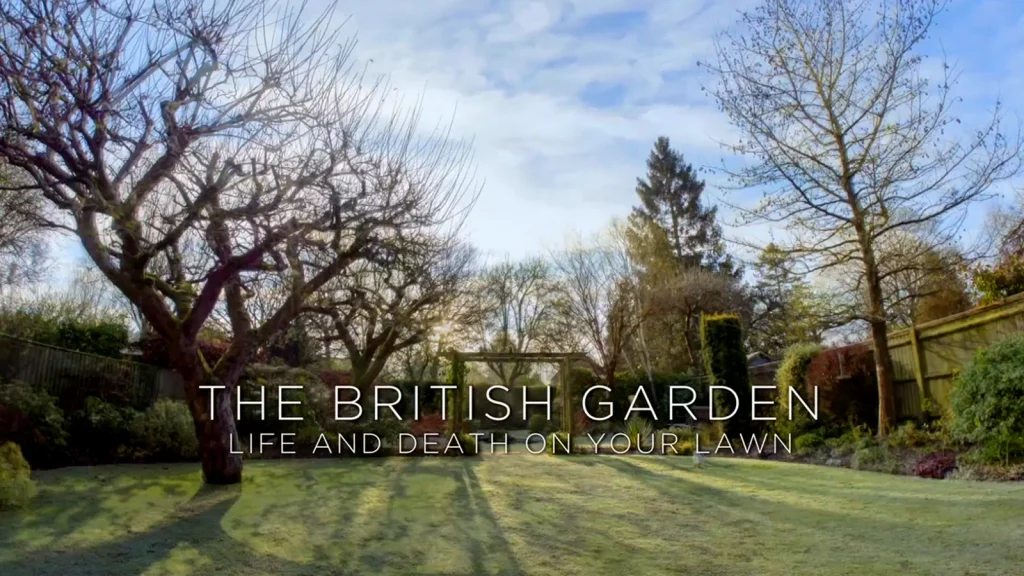Life and Death on Your Lawn – The quintessentially British back garden, often perceived as a quaint and orderly space, is in reality a teeming microcosm of the natural world, mirroring the vast Serengeti with its blend of beauty and raw survival. In an enthralling documentary, naturalist Chris Packham, alongside a team of seasoned wildlife specialists, embark on an immersive year-long journey.
Their exploration extends across a network of interconnected back gardens in the picturesque Welwyn Garden City. Their mission is pivotal: to unravel the extent of wildlife thriving right outside our homes. What diversity of life flourishes within the confines of the great British garden, often unnoticed by its human inhabitants?
As the year unfolds, Packham delves into the enigmatic lives of familiar garden creatures, uncovering surprising behaviors that challenge our usual perceptions. The summer months bring an intriguing revelation about a family of urban foxes, where a lone father figure leads the pack, and where a single litter of cubs can boast as many as five different fathers – a testament to the complex social dynamics in the animal kingdom.
The stark contrast of winter unveils another facet, where the charming red breast of a robin is reinterpreted as a symbol of territorial defiance, akin to war paint. The cycle completes in spring, where Packham stumbles upon a mesmerizing spectacle: a mass of frogs entwined in a frenetic dance of mating, an annual event that breathes new life into the garden ecosystem.
Throughout the seasons, this documentary not only showcases the incredible adaptability and resilience of garden wildlife but also poses critical questions about our role in nurturing these natural habitats. It’s a journey of discovery, revealing the hidden layers of life and drama in the seemingly mundane, and reminding us of the intricate connections that bind us to nature, even in our own backyards.
Unveiling the Hidden World of British Back Gardens
Introduction to the Miniature Serengeti
Imagine stepping outside into your backyard, only to find yourself in the midst of a bustling microcosm, teeming with life and narratives as rich and complex as those found in the Serengeti. This is the reality in the British garden – a hidden world of beauty and brutality, where the drama of life and death unfolds daily on your lawn.
In this hidden Eden, each blade of grass and every leaf tells a story, witnessed but seldom understood. Chris Packham, a renowned wildlife expert, takes us on a journey into this miniature world. With a keen eye and a deep appreciation for nature’s nuances, Packham reveals the intricate ecosystems thriving in our own backyards.
The Enigma of Back Gardens in Welwyn Garden City
Welwyn Garden City, a picturesque locale in the heart of Britain, stands as a testament to the untold wildlife sagas happening right beyond our back doors. In its back gardens, a hidden tapestry of life weaves its intricate patterns, largely unnoticed by its human inhabitants.
These gardens are not just plots of land but vibrant habitats where the cycle of life – birth, survival, and death – plays out in myriad forms. From the humble earthworm aerating the soil to the majestic birds of prey soaring above, each creature, big and small, plays a pivotal role in this ecological tapestry.
The journey into these gardens begins with a simple yet profound question: how much wildlife lives beyond our back doors, and how do these green spaces support their existence? This exploration is not merely an academic exercise; it is a voyage of discovery into the heart of nature that thrives in our midst.
The British garden is an enigma, hiding its secrets in plain sight. Yet, with careful observation and a touch of curiosity, we can begin to unravel the mysteries of this miniature Serengeti and appreciate the profound connection between our gardens and the wild world they harbor.
Seasonal Splendors and Secrets
Summer Mysteries: The Modern Family of Foxes
Dive into the warmth of a British summer and you’ll find a garden drama unfolding, starring none other than the fox – a creature often misunderstood, yet integral to our garden’s narrative. In Welwyn Garden City, these foxes are not mere passersby; they’re residents, raising their families under the watchful eyes of human neighbors.
Picture this: a single fox father, diligently caring for his young, challenging the traditional wildlife narratives. These fox families are a microcosm of adaptability and resilience, traits that echo through the undergrowth of our gardens. Each fox litter, intriguingly, can have multiple fathers, a testament to the complex social structures of urban wildlife.
Winter Revelations: The True Nature of the Robin – Life and Death on Your Lawn
As leaves fall and winter embraces the garden, the robin, a symbol of the British garden, takes center stage. Far from the gentle creature of popular imagination, the robin’s red breast is a badge of combat, a signal of territorial conquest in the frosty air.
Winter unveils a fierce competition for survival, where the robin’s sweet song becomes a war cry against intruders. This tiny bird, often romanticized in Christmas lore, is a warrior in its own right, a stark reminder of the relentless struggle for existence in our backyards. Understanding the robin’s true nature gives us a deeper appreciation for the life-and-death stakes playing out in our frost-covered gardens.
The Microcosm Beneath Our Feet – Life and Death on Your Lawn
Cricket Courtship: Bribes and Mating Rituals
Step into the hidden world beneath your feet, where the unassuming cricket plays out a courtship ritual as complex and intriguing as any Shakespearean drama. In the dense greenery of British gardens, these crickets are not just chirping background music; they are active participants in a sophisticated mating game.
Each male cricket, striving to win over a mate, offers more than just a serenade. They bring ‘nuptial gifts,’ food offerings that serve as bribes in this intricate dance of attraction. This behavior, a blend of romance and survival, sheds light on the delicate balance of nature in our backyards. The cricket’s song, often heard but seldom understood, is a symphony of desire and strategy, played out in the underbrush of our gardens.
Adaptive Predators: The Chameleonic Spiders
Now, shift your gaze to a more elusive garden inhabitant: the spider, an adaptive predator mastering the art of disguise and ambush. These spiders, often overlooked or misunderstood, are essential players in the garden’s ecosystem, maintaining a delicate balance.
Their ability to change color is not just a marvel of nature but a strategic advantage in the hunt for prey. This chameleon-like adaptation allows them to blend seamlessly into their surroundings, becoming both invisible and invincible. The garden spider, often viewed with unease, is in fact a guardian of our gardens, controlling insect populations and contributing to the ecological harmony. Their presence, a testament to nature’s ingenuity, reminds us of the complex interdependencies that define our backyard ecosystems.
Biodiversity in Our Backyards: A Scientific Inquiry
Counting Species: The Methodology and Challenges
Embark on a scientific journey to quantify the biodiversity in our very own back gardens. This task, far from trivial, requires meticulous planning and precision. The challenge lies not just in the counting, but in understanding the intricate web of life that thrives in these seemingly ordinary spaces.
Experts employ a variety of techniques, from simple observation to advanced technological aids, to capture a true picture of garden biodiversity. This process reveals the startling variety of species that call our gardens home, from the tiniest insects to the more conspicuous birds and mammals. Each species, no matter how small, contributes to the overall health and balance of the garden ecosystem.
Gardens as Wildlife Sanctuaries: Myths and Realities
In exploring the role of gardens as sanctuaries for wildlife, we uncover a blend of myth and reality. While gardens do provide refuge and resources for many species, their effectiveness varies widely based on factors such as plant diversity, garden size, and human activity.
The interplay between these elements determines how well a garden supports its wildlife inhabitants. Some gardens are bustling hubs of biodiversity, while others, perhaps more manicured or less diverse, may not offer the same level of support. Understanding these dynamics is crucial for enhancing our gardens’ potential as havens for wildlife.
Through this exploration, we gain a deeper appreciation for the role our gardens play in supporting local biodiversity. They are not just spaces for our enjoyment but vital ecosystems that sustain a rich variety of life, contributing to the broader ecological network of our neighborhoods and beyond.
Conclusions and Surprising Discoveries – Life and Death on Your Lawn
Evaluating Garden Types and Their Attraction to Wildlife
As we culminate our year-long exploration into the secret lives of British gardens, a revelation unfolds about the types of gardens that most attract wildlife. Contrary to popular belief, it’s not always the most manicured or largest gardens that play host to the greatest diversity of species. Smaller, more natural gardens, often bustling with a variety of plants and less human interference, emerge as true sanctuaries for wildlife.
This discovery challenges our traditional garden aesthetics and encourages us to rethink our approach to garden design. By embracing a more organic, less controlled garden environment, we can significantly enhance our local ecosystems. The variety of plants, the availability of natural habitats, and the reduction of chemical usage contribute to creating a thriving haven for wildlife, right in our backyards.
The Unexpected Findings and Their Implications
The journey through the British gardens brought to light unexpected findings, particularly regarding the adaptability and resilience of urban wildlife. Species once thought to be purely rural inhabitants are now thriving in suburban settings, displaying remarkable versatility. This adaptability points to a deeper, more profound connection between humans and nature than previously understood.
These findings carry significant implications for conservation efforts and urban planning. They underscore the importance of considering wildlife habitats in urban environments and the role of individual gardens in supporting biodiversity. As we move towards a more eco-conscious society, the insights gained from this exploration could inform future urban development, ensuring that nature has a place even in the most built-up areas.
Frequently Asked Questions – Life and Death on Your Lawn
Q1: What are some common misconceptions about wildlife in back gardens?
A1: Many people believe that wildlife in back gardens is limited to common birds and insects. However, there’s a surprising diversity, including mammals like foxes and a variety of insect species. Another misconception is that all wildlife is disruptive or harmful to gardens, while in reality, many species play crucial roles in maintaining ecological balance.
Q2: How can the average garden support more biodiversity?
A2: To support more biodiversity, gardeners can create diverse habitats by planting a variety of native species, providing water sources, and leaving areas a bit wild. Avoiding pesticides and creating structures like log piles and birdhouses also encourages wildlife to thrive in back gardens.
Q3: What are the implications of the findings for urban planning and wildlife conservation?
A3: The findings highlight the importance of green spaces in urban areas for biodiversity. Urban planning should incorporate more natural habitats and green corridors to support wildlife. For wildlife conservation, it’s clear that even small green spaces like back gardens can make a significant difference in preserving biodiversity in urban settings.
Q4: Can garden wildlife positively impact the mental health of residents?
A4: Yes, interacting with nature, including garden wildlife, has been shown to have positive effects on mental health, reducing stress and enhancing mood. Gardens can become peaceful retreats, offering therapeutic interactions with various forms of wildlife.
Q5: What steps can be taken to attract specific types of wildlife, like pollinators or birds?
A5: To attract pollinators, plant a variety of flowering plants that bloom at different times of the year. For birds, providing food sources, nesting boxes, and dense shrubbery for protection can make gardens more inviting.




